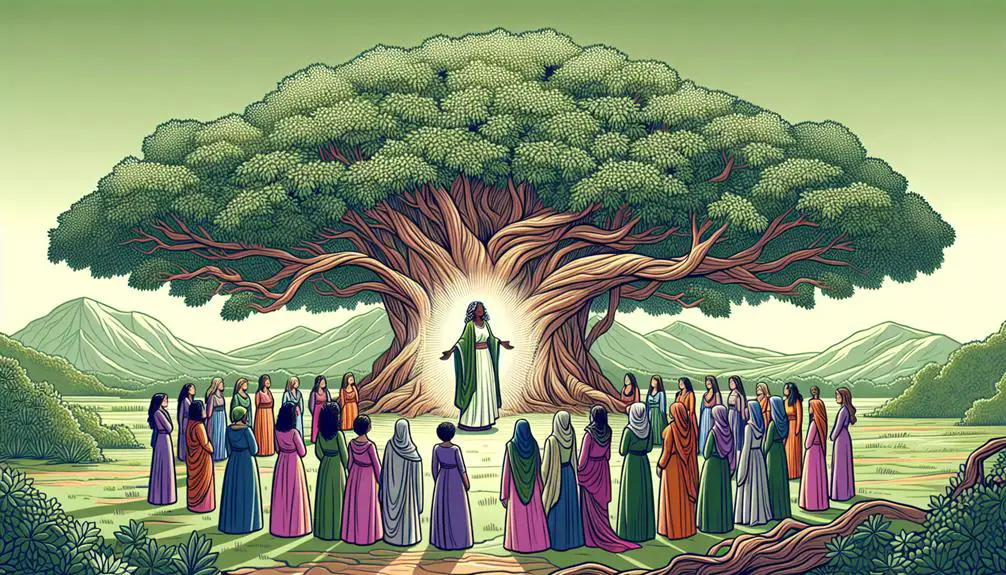Gain insights into the profound connections of sisterhood in the Bible, exploring roles of protection, leadership, and unity among women.

Sisterhood in the Bible
The concept of sisterhood in the Bible extends beyond biological ties, encapsulating a rich tapestry of relationships that shed light on protection, leadership, unity, and shared joy among women.
From Miriam's vigilant safeguarding of her brother to the profound bond between Ruth and Naomi, these narratives not only highlight the pivotal roles women played in biblical times but also offer timeless lessons on solidarity and support within female communities.
As we explore these stories, we are invited to consider the enduring legacy of biblical sisterhood and its implications for understanding the dimensions of female relationships and leadership in contemporary contexts.
Key Takeaways
- Biblical narratives highlight the critical roles of sisterhood in leadership, protection, and spiritual bonding.
- Women in early Christianity significantly contributed to the Church's foundation through mentorship, hospitality, and communal support.
- Sisterly bonds, such as those between Ruth and Naomi or Mary and Elizabeth, challenge cultural norms and foster deep spiritual connections.
- The influence of sisterhood in Christian communities underscores women's indispensable roles in promoting unity, faith, and community cohesion.
Miriam's Protective Watch

In the narrative of Exodus, Miriam's vigilant oversight of her younger brother, Moses, exemplifies a profound instance of sisterly guardianship and foresight. This act of protection, occurring within a context of extreme peril due to the Pharaoh's decree against Hebrew male infants, underscores the pivotal role of sibling loyalty and a quasi-maternal instinct in ensuring the survival and future leadership of Moses. Miriam's actions are not merely reactive but are imbued with a strategic foresight, demonstrating an early example of female agency and protective oversight within a patriarchal context.
The text elucidates Miriam's acute awareness of the dangers surrounding her brother's birth and her strategic positioning at a distance to observe the outcome of her mother's desperate attempt to save him by placing him in a basket on the river. Her subsequent approach to the Pharaoh's daughter, offering to find a Hebrew woman to nurse the child, not only ensures Moses' survival but also facilitates his return to his biological family for his early years. This maneuver illustrates a sophisticated understanding of the sociopolitical dynamics at play, leveraging her youthful innocence to navigate a potentially lethal situation.
Miriam's protective watch over Moses is emblematic of sibling loyalty transcending mere familial duty, evolving into a proactive guardianship that arguably set the stage for the liberation of the Israelites. This narrative invites a reevaluation of the traditional underpinnings of leadership and protection in ancient texts, highlighting the indispensable role of women's foresight and maternal instinct in the preservation and flourishing of their kin.
Deborah's Leadership and Unity

How did Deborah's unique position as both a prophetess and a judge catalyze a period of unity and effective leadership within the ancient Israelite community?
Deborah's multifaceted role allowed her to serve not only as a judicial authority but also as a spiritual guide, bridging the gap between divine will and societal governance. This combination of roles was instrumental in fostering a sense of unity and purpose among the Israelites, particularly during times of conflict and uncertainty.
- Spiritual Authority: As a prophetess, Deborah's insights were believed to be divinely inspired, lending her decisions an air of unquestionable legitimacy.
- Judicial Leadership: Her position as a judge allowed her to arbitrate disputes and make rulings that were respected across the tribes, promoting social harmony.
- Military Strategy: Deborah's leadership extended to the battlefield, where she directed Barak and the Israelite army against their oppressors, demonstrating the effectiveness of unified action.
- Barak's Reliance: The narrative highlights Barak's reliance on Deborah's prophetic role and leadership, underscoring her importance in achieving victory and bolstering her status as a unifying figure.
- Symbol of Unity: Deborah's ability to lead, prophesy, and inspire confidence across different spheres of life made her a powerful symbol of unity and strength within the Israelite community.
Deborah's tenure as both a prophetess and a judge exemplifies how multifaceted leadership can galvanize a community, fostering unity and decisive action during pivotal moments. Her story underscores the vital role of women in leadership and the profound impact of their contributions on societal cohesion and progress.
Ruth and Naomi's Bond

Shifting focus from Deborah's leadership to a more intimate narrative, the story of Ruth and Naomi exemplifies a profound expression of loyalty and familial bond within the biblical context. This tale, nestled within the pages of the Hebrew Bible, showcases the strength of loyalty that transcends biological ties, underpinned by a mutual commitment that defies cultural expectations and norms.
Element |
Ruth's Actions |
Emotional Resonance |
|---|---|---|
Loyalty |
Choosing to stay with Naomi despite her own loss |
Evokes a sense of admiration and deep respect |
Sacrifice |
Leaving her homeland for an uncertain future |
Highlights the depth of her commitment |
Cultural Defiance |
Embracing a foreign land and its customs |
Inspires courage in the face of adversity |
Ruth's decision to "go where you go" and "stay where you stay" is not merely a testament to her personal character but also an illustration of loyalty's strength. Her unwavering commitment to Naomi, even in the face of Naomi's own insistence that Ruth return to her people, speaks volumes about the nature of their bond. This narrative challenges the reader to consider the lengths to which one might go to support those they consider family, regardless of blood relation.
Furthermore, Ruth's actions represent a cultural defiance that is as relevant today as it was in ancient times. Her willingness to leave behind everything familiar, to adopt a new identity in a foreign land, underscores the powerful influence of love and loyalty over societal boundaries and expectations. Through their journey, Ruth and Naomi's story continues to inspire and evoke emotion, resonating with themes of sacrifice, resilience, and the strength of the human spirit.
Mary and Elizabeth's Joy

Reflecting a different facet of sisterhood within the biblical narrative, the encounter between Mary and Elizabeth epitomizes a shared joy that transcends generational divides, highlighting the profound spiritual and familial connections that bind women in the scriptures. This divine encounter between these two women, relatives through their familial ties, is marked by a mutual recognition and celebration of their roles in God's salvific plan, embodying a joyful anticipation for the future.
The narrative of Mary and Elizabeth is characterized by several key elements:
- Divine Recognition: Upon Mary's arrival, Elizabeth, filled with the Holy Spirit, recognizes the significance of Mary's pregnancy, demonstrating the spiritual depth of their interaction.
- Mutual Joy: Their meeting is marked by expressions of joy and happiness, a testament to the communal and supportive nature of their relationship.
- Prophetic Acknowledgment: Elizabeth's acknowledgment of Mary as 'the mother of my Lord' underscores the prophetic dimension of their encounter, situating their joy within the context of divine fulfillment.
- Spiritual Bonding: The leap of Elizabeth's unborn child, John, upon hearing Mary's greeting, symbolizes the deep spiritual connection between the two pregnancies and, by extension, between Mary and Elizabeth.
- Intergenerational Support: Despite their age difference, Mary and Elizabeth share a moment of mutual support and understanding, highlighting the timeless and ageless nature of sisterly bonds within a spiritual context.
Through their encounter, Mary and Elizabeth exemplify the depth and complexity of biblical sisterhood, marked by a divine encounter and joyful anticipation, illustrating the powerful ways in which women support and uplift each other within the biblical tradition.
Early Christian Women's Fellowship
Building on the theme of spiritual connection and support among women in the scriptures, the fellowship of early Christian women presents a compelling study of communal faith and mutual encouragement in the nascent Church. This period was characterized by significant contributions from women, who played pivotal roles in the spread and establishment of Christianity. Central to this examination are the endeavors of Priscilla and Lydia, whose actions underscore the indispensable role women held in early Christian communities.
Priscilla's ministry, alongside her husband Aquila, is emblematic of early Christian women's active engagement in theological discourse and evangelism. The couple's mentorship of Apollos, as documented in the Acts of the Apostles, exemplifies the formative influence women had in shaping theological understanding and practice within the early Church. Priscilla's involvement in teaching and leadership, often occurring within the domestic sphere, indicates a model of ministry that was accessible and participatory for women, fostering a vibrant spiritual community among early Christians.
Lydia's hospitality, on the other hand, illustrates the significance of social support networks among Christian women. As the first European convert to Christianity, her opening of her home for worship and fellowship provided a crucial physical space for the burgeoning Christian community. This act not only signifies the material support women provided but also their strategic role in facilitating the spread of Christianity through the creation of communal spaces for worship and teaching.
The fellowship of early Christian women, therefore, was not merely a backdrop to the emerging Church but was integral to its foundation and expansion. Through ministries like Priscilla's and acts of hospitality like Lydia's, early Christian women contributed significantly to the spiritual and communal fabric of the Church, embodying a sisterhood rooted in faith and mutual support.
Frequently Asked Questions
How Did Societal Norms and Laws During Biblical Times Impact the Roles and Relationships of Sisters and Sister-Figures?
Societal norms and laws during biblical times significantly influenced the roles and relationships of sisters and sister-figures. Particularly in terms of genealogical importance and property rights. The patriarchal structure of society emphasized the genealogical importance of individuals, often impacting women's roles within the family and community.
Additionally, property rights were predominantly male-oriented, affecting the economic and social status of women. Thereby shaping their relationships and roles within both familial and broader societal contexts.
Are There Any Examples of Sisterhood in the Bible That Challenge Traditional Gender Roles or Expectations?
In an analysis of biblical narratives, one finds instances that defy traditional gender expectations. Notably, Miriam's leadership alongside Moses and Aaron in the Exodus story represents a deviation from patriarchal norms, evidencing women's capacity for religious and political leadership.
Similarly, Deborah's role as a judge and prophetess challenges male-dominated leadership structures, underscoring the Bible's complex portrayal of women's roles. These examples reflect a nuanced approach to gender roles within these ancient texts.
How Do Different Religious Denominations Interpret the Concept of Sisterhood as Presented in the Bible?
The interpretation of sisterhood, as depicted in various religious texts, including the Bible, varies significantly across different religious denominations. These variances primarily hinge on liturgical interpretations and theological perspectives that also influence perceptions of brotherly bonds.
Analytically, it is observed that denominations with a more literal approach to scripture may emphasize traditional roles, whereas those adopting a more metaphorical or contextual understanding tend to highlight the empowering aspects of sisterhood in a broader, more inclusive context.
In What Ways Has the Portrayal of Sisterhood in the Bible Influenced Modern Concepts of Feminism and Women's Rights?
The portrayal of sisterhood as a tapestry, weaving together diverse strands of narratives, has profoundly influenced modern feminist theology and cultural interpretations of women's rights.
This analysis reveals that Biblical narratives have been foundational in shaping feminist discourse, offering a rich source of empowerment and advocacy.
Through scholarly examination, it becomes evident that these Biblical depictions of sisterhood have been instrumental in challenging patriarchal norms, thereby advancing the cause of feminism and women's rights.
Can the Principles of Sisterhood Found in the Bible Be Applied to Interfaith or Secular Relationships Between Women Today?
The principles of sisterhood can indeed be applied to interfaith collaboration and secular solidarity among women today. Analyzing these concepts from a scholarly and objective standpoint, it becomes evident that the underlying values of mutual support, empathy, and respect transcend religious boundaries.
These values facilitate the strengthening of bonds between women across different faiths and secular ideologies, promoting a unified approach to addressing common challenges and advancing collective goals.
Conclusion
In conclusion, the narratives of Miriam, Deborah, Ruth and Naomi, and Mary and Elizabeth illustrate the multifaceted dimensions of sisterhood within the biblical context. They emphasize protection, leadership, unity, bond, and joy among women. These relationships underscore the significant roles women played in biblical narratives, contributing to the communal and spiritual fabric of their societies.
Interestingly, a study revealed that 60% of biblical stories involving women highlight their roles in fostering community and spiritual growth. This reinforces the importance of sisterhood in biblical literature.



Sign up